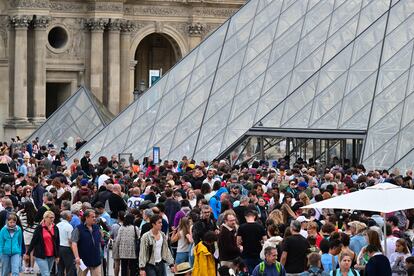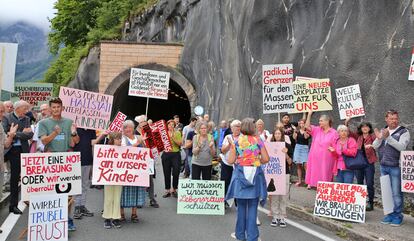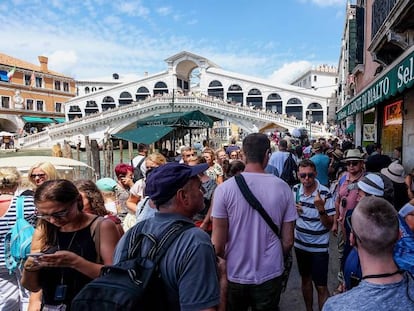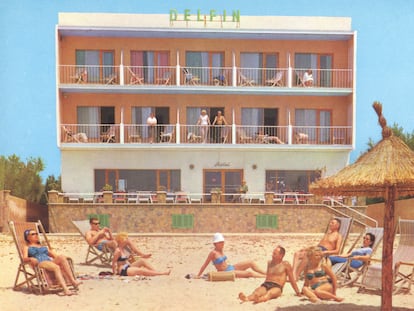Capping visitor numbers to protect cultural sites from overtourism
Several European cities, including Athens, Paris, and Venice, are limiting entry to their tourist attractions following the rush of visitors this summer. According to experts, the future holds greater tourist regulation across the continent

At noon on the last Sunday of summer, there were no more tickets left to enter the Acropolis. On foot and under the blazing sun, a handful of visitors who climbed the sacred hill that leads to the Parthenon came face to face with the new entry policy of the largest tourist attraction in the Greek capital. At the entrance, some tried to negotiate, but without success. “It’s like if you go to the theater and there are no seats: they won’t let you in. The same thing happens here,” a security guard, in an imitation of a Socratic dialogue, reasoned with a Brazilian tourist. Since the beginning of September, the monument has limited the number of visitors to 20,000 a day, at a rate of about 2,000 per hour. Those in charge want to avoid the risk of saturation caused by a glut of tourists in the summer, which forced a rapid intervention by the Greek authorities.
“Visits in June and early July alone had increased by 80% compared to 2019 figures. We were quickly reaching our limits,” argues the Greek Minister of Culture, Lina Mendoni. “The new measures, which set a certain number of visitors per hour, respond to the need to protect the monument, which is our main concern, in addition to improving the visitor experience at this historic site.” That is to say, art and heritage are better enjoyed without crowds and that they themselves are their first victims. After “extensive consultations” with tour operators, this new numerical limit was set. Until then, an average of 23,000 people a day were allowed in. “20,000 may seem like a slightly lower number, but the difference is important. Access to the Acropolis is through a single entrance. It was very difficult for the staff to attend to so many visitors. Furthermore, most groups visited the site before noon, which created real traffic jams.”
Weeks after the new regulations were implemented, the only queues in sight at Sunday rush hour were in front of the Parthenon. Dozens of visitors looked for the perfect angle to take a selfie, without being backlit and avoiding the scaffolding from the temple’s laborious restoration appearing in the frame. In the rest of the monument’s vast perimeter, the masses can wander unimpeded, following the guides who direct them briskly through the enclosure in a Babel of languages: English, French, Arabic, Chinese, and Spanish.
Those responsible for the site point out that, thanks to this new regulation, visits have been spread throughout the day, and not just between 9 a.m. and 1 p.m., as was customary. If a tourist is unable to find tickets for the morning, but can find tickets for the afternoon, they will gladly book their visit for later in the day. These measures have been put in place during a trial period lasting until April 2024, when the Greek government will reassess the situation. “If it is proven that the limit of 20,000 daily visitors is inefficient, we will not hesitate to change it,” says Mendoni. The Greek government’s project is to extend this policy to the 28 most popular monuments in the country, which are the focus of 90% of tourist visits. “It is clear that tourism is desirable for the country, it contributes to the GDP and generates thousands of jobs, but we have to find ways to prevent excess tourism from damaging not only our monuments, but also their physical and human environment. We must protect residents from noise, overcrowding, and rising rents. Tourism is a blessing, but we have to control overtourism.”

This neologism has become the bête noire of many European capitals that, not so long ago, focused their economic model on attracting massive numbers of visitors, before the matter got out of hand. In the middle of the last decade the numbers skyrocketed. In 2016, the number of tourists reached 1.2 billion worldwide, 300 million more than in 2010 and twice as many as in 1950. The boom in low-cost flights and platforms for temporary rentals accelerated the trend. Public spaces became congested. The ratio between visitors and residents got out of control. The commercial fabric was transformed. Cruise tourism affected the biosphere. And cities like Berlin, Lisbon, and Barcelona were filled with graffiti reading, “Tourists, go home.”
In 2019, when the number of tourist mobility had already reached 1.5 billion visitors per year and was close to the saturation point, the pandemic hit. “Until then, crowds were interpreted as an inevitable fact of life, but Covid showed that it was possible to limit tourist visits if steps were taken, and that this was good for the preservation of our monuments. Suddenly, imposing restrictions became feasible and, above all, acceptable,” says Ko Koens, a specialist in urban tourism at Inholland University in Amsterdam, another of the points on the European map that receives a massive influx of visitors.
Amsterdam has closed its cruise terminal in the historic center and has launched a campaign to discourage visits by rowdy British men, in addition to limiting night traffic in its red light district.
Since last spring, the Dutch city’s notorious red light district, which is famous for its tolerance of prostitution and drugs, has implemented measures focusing on relative rationalization: bars close at 1 a.m instead of 2 a.m, and the sex work has been interrupted between 3:00 and 6:00 in the morning. In mid-2023, Amsterdam closed its cruise terminal in the historic center and launched a campaign to discourage rowdy British men from behaving badly in the city. If they used keywords with hedonistic connotations in a search engine — alcohol, drugs, prostitution — the authorities reminded them, through these ads, that their acts of vandalism would be punished with fines. “Visitors will continue to be welcome, unless they misbehave and cause a nuisance,” said Sofyan Mbarki, the city’s deputy mayor. “Amsterdam is a metropolis, and that means bustle and liveliness. But, to keep it habitable, we have chosen limitation and not irresponsible growth.”
It is not the only city that has taken action on the matter. A month ago, while UNESCO was considering including it on its black list of endangered heritage, Venice announced a new tax of €5 ($5.30) for tourists who spend the day in the city, which receives some 30 million visitors a year. Intended only for day-trippers to Venice, it will be launched in spring 2024. Dubrovnik (Croatia), where only 41,000 people reside despite hosting some 1.5 million visitors a year, is also studying a cap on the number of cruise ships and the opening of new restaurants. In Iceland, the Fjaðrárgljúfur canyon had to close to the public after appearing in Game of Thrones and in a Justin Bieber video. And in Austria this August, groups of protesters demonstrated against tourism in the town of Hallstatt, a UNESCO World Heritage Site, where 700 inhabitants live, but which receives about 10,000 visitors a day in high season.
In Paris, after the hiatus marked by the pandemic, the Louvre Museum also opted for tourist limits in June 2022: since then, it has put a maximum of 30,000 tickets per day on sale and only grants entry to spontaneous visitors “in cases of low attendance.” To enter, in most cases, you have to buy a ticket online and in advance.
In Spain, although caps on visitor numbers exist in national parks and other heritage sites such as prehistoric caves, they do not affect museums. The Reina Sofía Museum in Madrid, which received three million visitors in 2022, is not considering implementing measures like those at the Louvre. Last year, the Spanish museum sold 67% of admissions at the ticket office, compared to 28% purchased online. Reservations are obligatory only for groups and in the case of blockbuster exhibitions, such as those featuring Dalí or Picasso, with limited visitor capacity. The Prado Museum, which had 2.5 million visitors in 2022, has a maximum capacity of 3,000 visitors per hour (about 30,000 visitors daily), which its managers say has “never been reached.” Currently, the average is 9,000 visitors a day. For its part, the Alhambra in Granada does have a maximum capacity of 2,763,500 visitors per year, for conservation reasons. The figure was exceeded in 2019, so to prevent this from happening again, it is finalizing a system to access the Nasrid palaces in 30-minute intervals, with a maximum of 300 visitors each.

Koens believes that, over the next decade, increasingly strict regulations will be imposed. “If progress continues at the same pace, within 10 years Amsterdam will welcome 25% more tourists. That is, five or six more than the current 21 million. It is worth asking if there is enough space for those numbers,” says the expert, although he predicts problems if freedom of movement in public spaces is restricted. For example, limiting pedestrian traffic in certain neighborhoods. “Who would have the right to enter and who would not? I myself don’t live in the center of Amsterdam. Will I be prevented from accessing certain places? It can be a minefield, but it should not be ruled out. European town councils are studying all the possibilities. It won’t happen immediately, but I wouldn’t be surprised if these measures are imposed in the medium term.” There are others that are even more extreme. For example, since 2020, the Swiss economist Bruno Frey has proposed building “recreated originals,” which are identical replicas of the most visited tourist sites in places close to their actual location.
After the long pandemic hiatus, the return of mass tourism this summer has marked a turning point. Europe is the region which sees over half of the tourist visits in the world — 54% of the total, according to the latest data. The continent’s visitor numbers reached 91% of 2019 occupancy during the first half of 2023, according to the latest United Nations barometer of the World Tourism Organization (UNWTO). In the Mediterranean there was an increase of 1%. In the absence of official figures, everything indicates that this trend intensified during the summer months. The return to normality has taken place in record time: in January 2021, the number of tourists had fallen by 86% compared to the months before the outbreak of Covid-19.
The authorities are now solving a problem from 2019 with the tools that managing the pandemic has bequeathed them. “For me, overtourism does not exist. What exists is poor management of flows,” says Alessandra Priante, regional director for Europe at the UNWTO. “Today’s tourism requires programming. The more we plan, as visitors and institutions, the better the result will be. In cases like those of Venice or the Parthenon, it is a question of survival. Regulation will become widespread in the coming years. Not only for the inhabitants of those cities, but also for the tourist, who is still a temporary resident. You can’t force a visitor not to go to a place, but you can offer them an alternative or an incentive. For example, if you don’t come this weekend but do so in two weeks, we will offer you a free benefit.”
The capacity to accommodate large numbers of visitors is not a new problem. In the United States, national parks began to apply entry limits in the 1980s, as did some of the so-called wonders of the world, such as Machu Picchu, in Peru. What is new is its recent extension to cultural tourism in an urban environment. Despite everything, some specialists doubt its effectiveness. “The problem is not the queue at the Parthenon or the Louvre, but gentrification, tourist housing, and the privatization of public space,” argues Claudio Milano, researcher in social anthropology at the University of Barcelona. “Imposing dissuasive fees or installing turnstiles at the entrance to Venice are short-term measures, an urban sticking plaster that does not affect the structural elements.”
For Milano, this “technocratic” desire to decongest tourism will not change anything. It will allow politicians to send a message of firmness regarding mass tourism in order to reduce anti-tourist sentiment in some parts of the European map. For the rest, it will benefit the same model that began to take shape a couple of decades ago. “It will simply move the focus of growth to other places. Once the center has been taken over, we will dedicate ourselves to “touristifying” the outskirts. Expressions such as ‘quality tourism’ hide a desire to stigmatize the visitor with less purchasing power and attract the elites, capable of paying more and spending more money. Sanitizing cities to encourage consumption has already been underway for some time. Public space has become a place to consume, rather than to live.”
Sign up for our weekly newsletter to get more English-language news coverage from EL PAÍS USA Edition
Tu suscripción se está usando en otro dispositivo
¿Quieres añadir otro usuario a tu suscripción?
Si continúas leyendo en este dispositivo, no se podrá leer en el otro.
FlechaTu suscripción se está usando en otro dispositivo y solo puedes acceder a EL PAÍS desde un dispositivo a la vez.
Si quieres compartir tu cuenta, cambia tu suscripción a la modalidad Premium, así podrás añadir otro usuario. Cada uno accederá con su propia cuenta de email, lo que os permitirá personalizar vuestra experiencia en EL PAÍS.
¿Tienes una suscripción de empresa? Accede aquí para contratar más cuentas.
En el caso de no saber quién está usando tu cuenta, te recomendamos cambiar tu contraseña aquí.
Si decides continuar compartiendo tu cuenta, este mensaje se mostrará en tu dispositivo y en el de la otra persona que está usando tu cuenta de forma indefinida, afectando a tu experiencia de lectura. Puedes consultar aquí los términos y condiciones de la suscripción digital.
More information
Últimas noticias
Most viewed
- Sinaloa Cartel war is taking its toll on Los Chapitos
- Oona Chaplin: ‘I told James Cameron that I was living in a treehouse and starting a permaculture project with a friend’
- Reinhard Genzel, Nobel laureate in physics: ‘One-minute videos will never give you the truth’
- Why the price of coffee has skyrocketed: from Brazilian plantations to specialty coffee houses
- Silver prices are going crazy: This is what’s fueling the rally











































